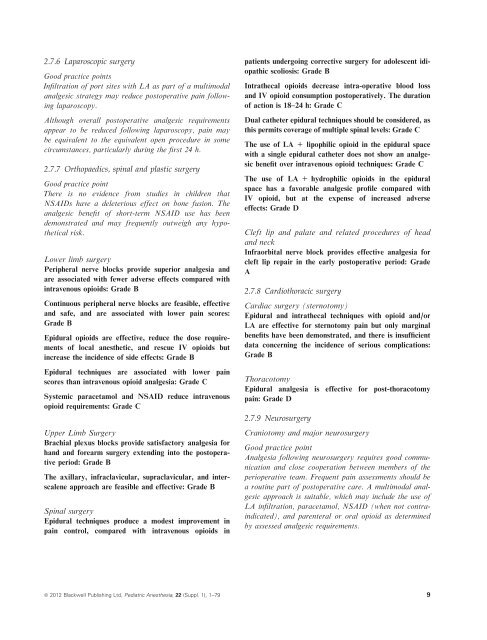Good Practice in Postoperative and Procedural Pain Management ...
Good Practice in Postoperative and Procedural Pain Management ...
Good Practice in Postoperative and Procedural Pain Management ...
You also want an ePaper? Increase the reach of your titles
YUMPU automatically turns print PDFs into web optimized ePapers that Google loves.
2.7.6 Laparoscopic surgery<strong>Good</strong> practice po<strong>in</strong>tsInfiltration of port sites with LA as part of a multimodalanalgesic strategy may reduce postoperative pa<strong>in</strong> follow<strong>in</strong>glaparoscopy.Although overall postoperative analgesic requirementsappear to be reduced follow<strong>in</strong>g laparoscopy, pa<strong>in</strong> maybe equivalent to the equivalent open procedure <strong>in</strong> somecircumstances, particularly dur<strong>in</strong>g the first 24 h.2.7.7 Orthopaedics, sp<strong>in</strong>al <strong>and</strong> plastic surgery<strong>Good</strong> practice po<strong>in</strong>tThere is no evidence from studies <strong>in</strong> children thatNSAIDs have a deleterious effect on bone fusion. Theanalgesic benefit of short-term NSAID use has beendemonstrated <strong>and</strong> may frequently outweigh any hypotheticalrisk.Lower limb surgeryPeripheral nerve blocks provide superior analgesia <strong>and</strong>are associated with fewer adverse effects compared with<strong>in</strong>travenous opioids: Grade BCont<strong>in</strong>uous peripheral nerve blocks are feasible, effective<strong>and</strong> safe, <strong>and</strong> are associated with lower pa<strong>in</strong> scores:Grade BEpidural opioids are effective, reduce the dose requirementsof local anesthetic, <strong>and</strong> rescue IV opioids but<strong>in</strong>crease the <strong>in</strong>cidence of side effects: Grade BEpidural techniques are associated with lower pa<strong>in</strong>scores than <strong>in</strong>travenous opioid analgesia: Grade CSystemic paracetamol <strong>and</strong> NSAID reduce <strong>in</strong>travenousopioid requirements: Grade CUpper Limb SurgeryBrachial plexus blocks provide satisfactory analgesia forh<strong>and</strong> <strong>and</strong> forearm surgery extend<strong>in</strong>g <strong>in</strong>to the postoperativeperiod: Grade BThe axillary, <strong>in</strong>fraclavicular, supraclavicular, <strong>and</strong> <strong>in</strong>terscaleneapproach are feasible <strong>and</strong> effective: Grade BSp<strong>in</strong>al surgeryEpidural techniques produce a modest improvement <strong>in</strong>pa<strong>in</strong> control, compared with <strong>in</strong>travenous opioids <strong>in</strong>patients undergo<strong>in</strong>g corrective surgery for adolescent idiopathicscoliosis: Grade BIntrathecal opioids decrease <strong>in</strong>tra-operative blood loss<strong>and</strong> IV opioid consumption postoperatively. The durationof action is 18–24 h: Grade CDual catheter epidural techniques should be considered, asthis permits coverage of multiple sp<strong>in</strong>al levels: Grade CThe use of LA + lipophilic opioid <strong>in</strong> the epidural spacewith a s<strong>in</strong>gle epidural catheter does not show an analgesicbenefit over <strong>in</strong>travenous opioid techniques: Grade CThe use of LA + hydrophilic opioids <strong>in</strong> the epiduralspace has a favorable analgesic profile compared withIV opioid, but at the expense of <strong>in</strong>creased adverseeffects: Grade DCleft lip <strong>and</strong> palate <strong>and</strong> related procedures of head<strong>and</strong> neckInfraorbital nerve block provides effective analgesia forcleft lip repair <strong>in</strong> the early postoperative period: GradeA2.7.8 Cardiothoracic surgeryCardiac surgery (sternotomy)Epidural <strong>and</strong> <strong>in</strong>trathecal techniques with opioid <strong>and</strong>/orLA are effective for sternotomy pa<strong>in</strong> but only marg<strong>in</strong>albenefits have been demonstrated, <strong>and</strong> there is <strong>in</strong>sufficientdata concern<strong>in</strong>g the <strong>in</strong>cidence of serious complications:Grade BThoracotomyEpidural analgesia is effective for post-thoracotomypa<strong>in</strong>: Grade D2.7.9 NeurosurgeryCraniotomy <strong>and</strong> major neurosurgery<strong>Good</strong> practice po<strong>in</strong>tAnalgesia follow<strong>in</strong>g neurosurgery requires good communication<strong>and</strong> close cooperation between members of theperioperative team. Frequent pa<strong>in</strong> assessments should bea rout<strong>in</strong>e part of postoperative care. A multimodal analgesicapproach is suitable, which may <strong>in</strong>clude the use ofLA <strong>in</strong>filtration, paracetamol, NSAID (when not contra<strong>in</strong>dicated),<strong>and</strong> parenteral or oral opioid as determ<strong>in</strong>edby assessed analgesic requirements.ª 2012 Blackwell Publish<strong>in</strong>g Ltd, Pediatric Anesthesia, 22 (Suppl. 1), 1–79 9
















